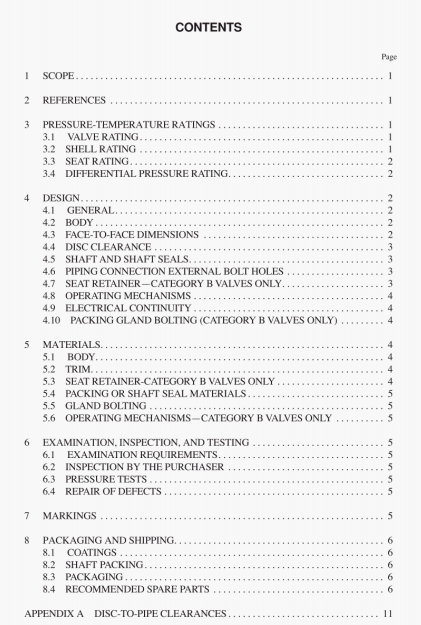API 609:2004 pdf download.Butterfly Valves: Double Flanged, Lug- and Wafer-Type.
For valves that arc not fully rated, each size and pressure class of threaded-lug or double flanged butterfly valve, the manufacturer shall perform prototypical tests in both flow directions to determine the maximum pressure (up to 1.1 times the valve’s rated differential pressure) that produces a leak rate acceptable per API Standard 59X for each flow direction (or a single flow direction for unidirectional valves). For bidirectional dead-end service valves, tests shall be performed with the seat retainer side of the prototypical test valve fully unrestrained. For unidirectional dead-end service valves, test shall be performed with the downstream side of the prototypical Lest valve fully unrestrained.
Based on these tests, the manufacturer shall mark each valve stating maximum bidirectional dead-end pressure xxx, where xxx represents 90% of the lowest pressure in either flow direction determined from the prototypical tests. For unidirectional valves the marking shall be maximum unidirectional dead-end pressure xxx. where .ux represents Si0% of the lowest pressure in the appropriate direction determined from the prototypical tests. Additionally, the manufacturer will include this information in catalogs and installation, maintenance, and operating documents.
4.8 OPERATiNG MECHANISMS
4.8.1 Levers, gear operators. handwheel. and automatic actuators shall be equipped with provisions to prevent movement of the disc from the desired set position during normal operating conditions. Norma) operating conditions include throttling service when specified by the purchaser.
4.8.2 In addition to the requirements of the valve design. torque requirements for operation vary considerably with changes in flow media, operating pressure. and fluid velocity. Conditions under which valves are to be operated must be specified by the purchascr and carefully evaluated by the manufacturer to determine the maximum resultant torque. Actuators shall be compatible with the operating torque requirements.
4.8.3 Valves shall be closed by turning the shaft and attached operating device (such as a handle) in the clockwise direction.
4.8.4 The operating mechanism (wrench or gear) shall be designed such that the operator input force required to operate the valve at the manufacturer’s published torque requirement. does not exceed the operator input force capability.
API 609:2004 pdf download
